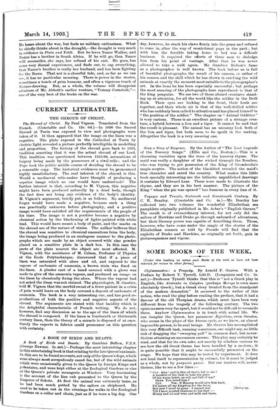C URRENT LITERATURE.
THE SHROUD OF CHRIST.
The Shroud of Christ. By Paul Vignon. Translated from the French. (Constable and Co. 125. 6d.)—In 1898 the Sacred Shroud at Turin was exposed to view and photographs were taken of it. It then appeared that the image on the linen was a negative. The plate exposed in the Cathedral at Turin by electric light revealed a picture perfectly intelligible in modelling and proportion. The history of the shroud goes back to 1353, tradition asserting that it was the actual shroud of our Lord. This tradition was questioned between 1355-89, accusations of forgery being made by the possessors of a rival relic ; and the Pope took the politic middle course of deciding the shroud to be a venerable copy. The historical evidences must be pronounced highly unsatisfactory. The real interest of the shroud is this. Would a mediaeval relic-maker have thought of Producing a negative image which no one would have ruiderstood ? The farther interest is that, according to M. Vignon, this negative might have been produced naturally by a dead body, though the fact does not bring any evidence of the body's identity. M. Vignon's arginnent, briefly put, is as follows. Ng mediaeval forger would have made a negative, because such a. thing was practically unknown befpre photography, and a positive image would have satisfied all the requirements of the, people of his time. The image is not a positive become a negative by chemical action by the blackening of lights painted with white lead. This would have meant a body of paint, and the marks on the shroud are of the nature of stains. The author believes that the shroud was sensitive to 'chemical emanations friM the body, the image being produced in an analogous manner' to the photo- graphs which are made by an object covered with zinc powder placed on a sensitive plate in a dark box. In this case the parts of the plate nearest the object' are most : affected. M. Vignon, with the assistance of M. COlscsi, Profethei bf Physics at the took Polytechnique; discovered that if a Piece of linen was saturated with aloes and oil, and exposed to the vapour of carbonate of ammonia, a, brown stain as fixed on the-linen. A plaster cast, of a hand covered with a glove was made to give off the ammonia vapour, and produced an image on the linen by chemically fixing the aloes. Where the vapour had not acted the linen was not stained. The physiologist, M. Gautier,
• told M. Vignon that the morbid sweat of a fever patient in a crisis of pain would leave on the body covered a deposit of carbonate of ammonia. The book is a very, interesting one, and has good re- productions of both the positive and negative aspects of the shroud. The arguments are stated with that lucidity which is the delightful characteristic of French writing. We do not, however, find any discussion as to the age of the linen Of whieh the shroud is composed. If the linen is fourteenth or 'thirteenth century linen, then the theory of a miracle is disposed of at once. Surely the experts in fabrics could pronounce on this question with certainty.










































 Previous page
Previous page